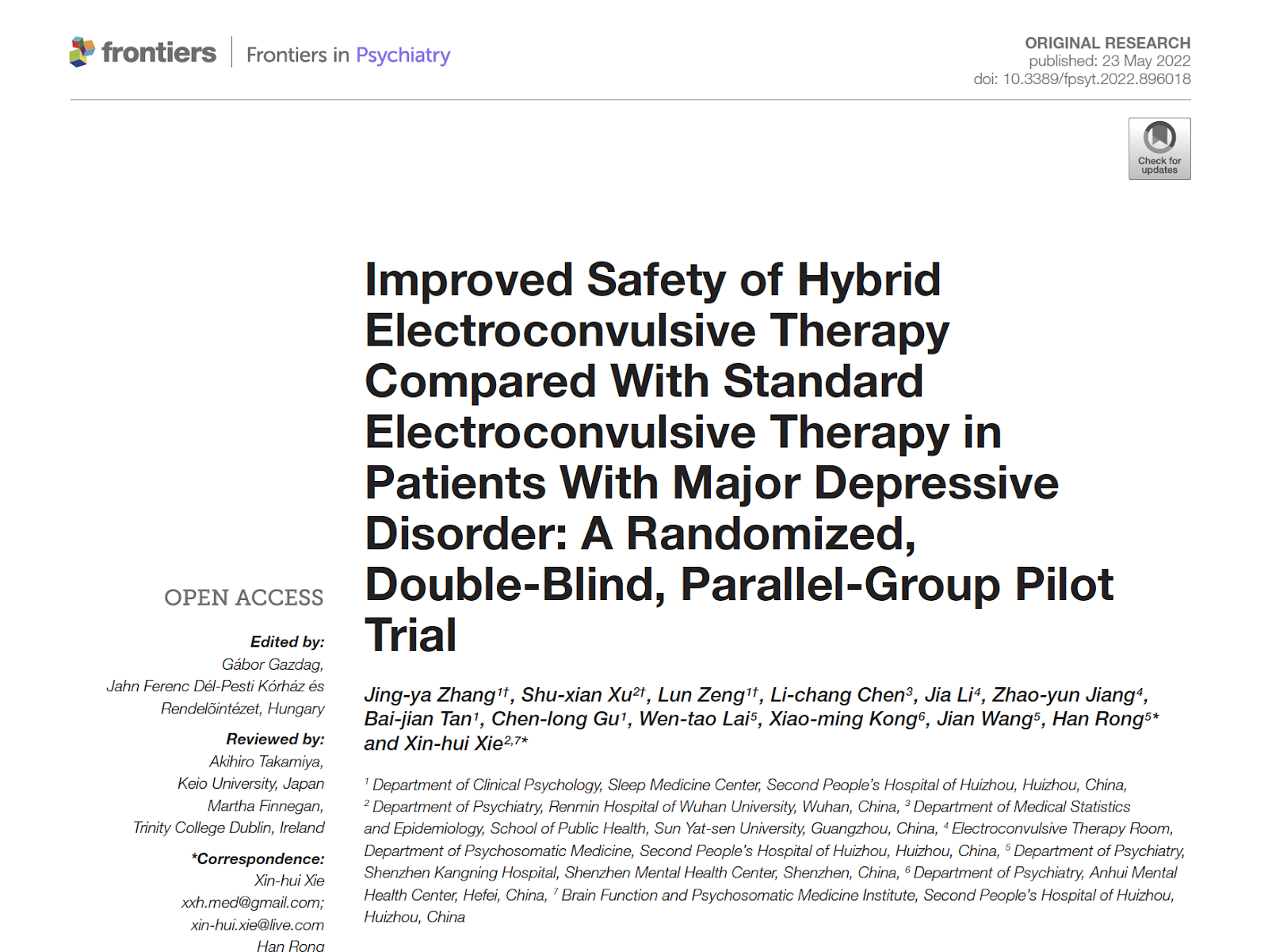Trial of "Hybrid ECT" From China
Out on PubMed, from investigators in China, is this study:
Improved Safety of Hybrid Electroconvulsive Therapy Compared With Standard Electroconvulsive Therapy in Patients With Major Depressive Disorder: A Randomized, Double-Blind, Parallel-Group Pilot Trial.
Objectives: ECT is a rapid and effective treatment for depression. While efficacy is often remarkable over the initial 3-4 sessions, the efficacy of later sessions is less rapid, and the side-effects, especially cognitive impairment limit its use. To preliminarily compare the efficacy and acceptability of a novel hybrid-ECT (HECT) protocol for patients with major depressive disorder (MDD) with standard ECT, we conducted this pilot trial.
Methods: Thirty patients were randomly assigned to ECT or HECT. Both arms received three ECT sessions (phase 1) but, in phase 2, the HECT arm received low-charge electrotherapy instead of ECT. The primary outcome was the change in 24-item Hamilton depression rating scale (HAMD-24) scores between baseline and the end of treatment. Cognitive function was assessed by repeatable battery for the assessment of neuropsychological status (RBANS), Stroop color word, and orientation recovery tests (ORT). Safety was measured by the drop-out rate and adverse events (AEs). Four visits were conducted at baseline, post-phase 1, post-phase 2, and at 1-month follow-up. Trial registration: Chinese Clinical Trial Registry (http://www.chictr.org.cn/), identifier: ChiCTR1900027701.
Results: Patients in both arms showed significant within-group improvements in HAMD-24, but the between-group differences were non-significant. Participants in the HECT arm outperformed ECT patients for most cognitive tests at the end of treatment or at follow-up. There was a significantly lower AE rate and shorter ORT in phase 2 of the HECT ar.
Conclusion: In this pilot trial, HECT was associated with fewer AEs and better cognitive function including executive and memory function, but its possible similar antidepressive efficacy needs to be further investigated in future.
Keywords: adverse event; cognitive function; controlled trial; double-blind; electroconvulsive therapy; hybrid electroconvulsive therapy; major depressive disorder; randomized.


After many years of assertions that the seizure is the key therapeutic element in ECT, there are still investigators who believe differently; thus, a protocol, tested here, called "hybrid ECT", that uses low charge stimuli and is agnostic as to whether or not a seizure is elicited. But if the authors don't show the data about how often patients in the hybrid arm had seizures, the study results are very hard to interpret.
Improved Safety of Hybrid Electroconvulsive Therapy Compared With Standard Electroconvulsive Therapy in Patients With Major Depressive Disorder: A Randomized, Double-Blind, Parallel-Group Pilot Trial.
Objectives: ECT is a rapid and effective treatment for depression. While efficacy is often remarkable over the initial 3-4 sessions, the efficacy of later sessions is less rapid, and the side-effects, especially cognitive impairment limit its use. To preliminarily compare the efficacy and acceptability of a novel hybrid-ECT (HECT) protocol for patients with major depressive disorder (MDD) with standard ECT, we conducted this pilot trial.
Methods: Thirty patients were randomly assigned to ECT or HECT. Both arms received three ECT sessions (phase 1) but, in phase 2, the HECT arm received low-charge electrotherapy instead of ECT. The primary outcome was the change in 24-item Hamilton depression rating scale (HAMD-24) scores between baseline and the end of treatment. Cognitive function was assessed by repeatable battery for the assessment of neuropsychological status (RBANS), Stroop color word, and orientation recovery tests (ORT). Safety was measured by the drop-out rate and adverse events (AEs). Four visits were conducted at baseline, post-phase 1, post-phase 2, and at 1-month follow-up. Trial registration: Chinese Clinical Trial Registry (http://www.chictr.org.cn/), identifier: ChiCTR1900027701.
Results: Patients in both arms showed significant within-group improvements in HAMD-24, but the between-group differences were non-significant. Participants in the HECT arm outperformed ECT patients for most cognitive tests at the end of treatment or at follow-up. There was a significantly lower AE rate and shorter ORT in phase 2 of the HECT ar.
Conclusion: In this pilot trial, HECT was associated with fewer AEs and better cognitive function including executive and memory function, but its possible similar antidepressive efficacy needs to be further investigated in future.
Keywords: adverse event; cognitive function; controlled trial; double-blind; electroconvulsive therapy; hybrid electroconvulsive therapy; major depressive disorder; randomized.
The article is here.
And from the text:


Apart from the clinical trial itself, the discussion of speed of response to ECT is interesting.
But, once again, I object to minor differences in cognitive testing being called a "safety" issue, when they are clearly no more than tolerability issues. This protocol is either innovative or slightly misguided; if the former, it needs to be replicated and expanded upon (particularly, as the authors note, with relapse data); if the latter, we should read the paper with interest (~ 15 minutes), give kudos to the authors for their attempt, and move on.




Of course, it is not surprising that a lower charge leads to a lower level of cognitive impairment.
ReplyDeleteWhat is indeed surprising is that cognitive impairment is seen as a safety risk. Of course, this is a tolerability effect - as mentioned by Charlie Kellner above.
What is really extremely surprising is that since stimulations around the seizure threshold carry a high risk of protracted or tardive seizures, that this study in itself is not called a safety risk.
And b.t.w. why this should be called hybrid?